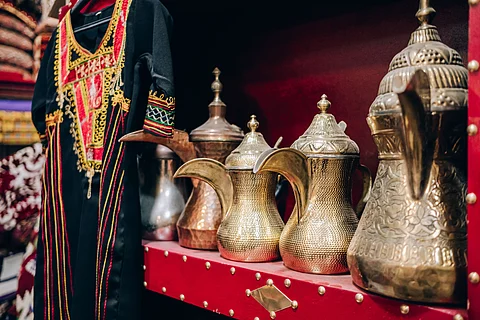
- Destinations
- Experiences
- Stay
- What's new
- Celebrating People
- Responsible Tourism
- CampaignsCampaigns
- Subscribe
- Buy Now

Souvenirs from Saudi | One of the most delightful aspects of shopping in Saudi Arabia is the opportunity to explore its rich tradition of local handicrafts. As you wander through the souqs, your eye will be drawn to delicately embossed Qurans, carpets, prayer beads, dates, spices, gold and silver accessories, camel milk chocolate, oud and musk perfumes, traditional clothing, and more—the options are truly limitless!
Originating in the Arabian region, oud is derived from the heartwood of the aquilaria tree, whose resin can be distilled into oil, blended into perfume or simply burned as incense. Much like dates, oud products are a symbol of Saudi hospitality.
The fragrance comes in various forms, each with its own unique scent profile. From the deep, earthy notes of agarwood to the lighter, sweeter aromas, there’s an oud for every preference. When shopping for oud, explore the different types available, such as Oud Al-Hindi, known for its rich and complex scent, or Oud Al-Saudi, which offers a more traditional fragrance.
Dates are a staple of the Saudi diet. They are also a sign of hospitality, frequently offered to guests and tourists alike.
Where to buy: Al Madinah is famous for cultivating and producing a large number of the finest types of dates, called ajwa, which can be packed and shipped anywhere in the world. There’s also sukkari, which are incredibly sweet and juicy, and medjool dates, often referred to as the “king of dates” for their size and taste. Be sure to sample a few before purchasing, as each variety offers a unique experience.
Saudi rugs are made from wool and come in an overwhelming variety of sizes, designs and colours. Among the most sought-after are sadu rugs, known for their geometric patterns and vibrant colours, which reflect the nomadic lifestyle of the Bedouins. Meanwhile, Persian rugs showcase intricate designs and elaborate craftsmanship. Whether you prefer traditional or contemporary styles, you’ll find a rug that speaks to you.
Where to buy: The Dirah Souq in Riyadh and Souq Al Zal in Old Riyadh are recommended places to buy rugs. The quality of the rugs in the souqs can vary, so be sure to compare a few of them rather than buying the first one that catches your eye.
The life cycle of Taif’s roses begins in December each year when farmers return to care for their fields and bushes. After 55 days, their scent mixes with the lush juniper trees in the gardens’ paths. The rich colours of nature mix, and it's only in early spring when the rose petals are picked. They are then transported in bushels to Taif’s rose oil extraction factories who churn out them out in both rosewater and fragrance form.
Where to buy: If you plan to visit Taif, check out the annual Taif Rose Festival, which features live performances, music and perfume-making workshops. The best place to pick up a Taif product is the Rashid Al Qurashei Factory.
Saudi Arabia's traditional “flip flops” will remind you of Sindhi mojaris. Originally made out of camel leather, the madas’ traditional motifs and detailed embroidery make them quintessentially Saudi. Their design accommodates the region’s sandy nature, and they come in a variety of colours.
Where to buy: You will find a good collection of these Saudi “flip flops” in the old souqs, rather than malls.
Saudi cuisine is a delightful blend of flavours, and spices play a crucial role in defining its unique taste. Bringing home a selection of spices is a fantastic way to recreate the flavours of Saudi Arabia in your own kitchen.
Among the most popular spices are za’atar, a fragrant blend of herbs; sumac, known for its tanginess; and kabsa, which is sprinkled on the Saudi national dish of the same name. Saffron, often called “red gold,” adds a luxurious touch to dishes.
Where to buy: You’ll find the freshest spices in local markets like the Al-Masmak Souq in Riyadh. Don’t hesitate to ask vendors for advice on how to use these spices in your cooking.
Al-Qatt Al-Aseeri is a style of South Arabian art typically painted by women for the entrance to a home. It originated in the Aseer region of Saudi Arabia, where the front parlour of traditional Arab homes normally contained wall paintings in the form of a mural or fresco with geometric designs in bright colours.
Where to buy: The best place to find Al-Qatt Al-Aseeri engraved products like tea and coffee cups, dishes, and stationery is in Abha, the capital of Aseer.
